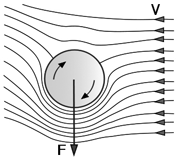E-Archive
Off the Beaten Track
in Vol. 10 - November Issue - Year 2009
The Magnus Effect

Magnus effect

Sea vessel using Magnus effect

Airplane using rotating cylinders
It was a perfect day for a walk on the beach. Hand in hand, the young couple strolled slowly on the soft gray sand, savoring the warmth of the sun on their faces and the sweet smell of the sea carried by the breeze. Lydia Flettner was grateful for this moment alone with her husband, whom she rarely had the chance to see during the day. She glanced briefly at his face and smiled as she saw him deep in thought. She had become accustomed to being married to a man who was totally absorbed with his work and who had the fascination of a child for anything that was related to aviation. She watched as he stopped abruptly and lowered himself slowly to his knees, scooping up sand with one hand and pouring it slowly over his other hand, which was clenched in a tight fist. She saw his eyes light up and she realized, not without a tinge of disappointment, that he had stumbled upon something important, something that would probably keep him in his laboratory until late at night for the next few weeks…
*****
Anton Flettner was an aviation engineer and inventor, born in Eddersheim, Germany in the year 1885. He was a teenager when the first powered flight took place and he quickly became intrigued by the physics of air and wind, by the dynamics of lift. He devoured any book that dealt with flight and, while World War I was raging in Europe, he had invented the trim tab for aircraft. He continued his research and studies under the guidance of Count Ferdinand von Zeppelin, the inventor of the modern gas-filled airship.
The walk on the beach which Anton Flettner took with his wife was a fundamental turning point in his life. While observing the flow of sand over his fist, he realized that it would be possible to create a propulsion system based on the Magnus effect, which had been defined by the German physicist Heinrich Magnus in 1852, but which had been described as early as 1672 by Isaac Newton.
The Magnus effect is a phenomenon by which a spinning object passing through a fluid creates a whirlpool of fluid around itself and experiences a force perpendicular to the object’s line of motion. When observing a spinning ball flying through the air, the Magnus effect explains the curved trajectory of the ball. The importance of Flettner’s intuition lies in the fact that this curved motion indicates that lift is being created and that this lift can be used to propel ships through the water or sustain aircraft in the air.
In October 1924, Flettner constructed an experimental rotor ship by refitting an old schooner. This sea vessel carried two cylinders, or rotors, about fifteen meters high and about three meters in diameter which were driven by an electric propulsion system. The idea worked, although the propulsion force generated was less than the motor would have generated had it been connected to a normal marine propeller. After successfully completing its sea trials, the ship crossed the Atlantic Ocean, travelling to New York via South America and calling on several ports along the way, where it attracted great attention and caused quite a sensation. The rotors worked perfectly well even during some storms which the ship passed through on its voyage.
Notwithstanding the positive results of this voyage, Flettner abandoned the idea of developing rotor systems on sea vessels, as these systems were less efficient than conventional engines. Since tests carried out in a wind tunnel showed that a rotating cylinder created up to ten times more lift than a traditional fixed wing, Flettner started applying his revolving cylinders to aircraft, on which the propulsion was given by a traditional propeller, but where the lift was provided by rotating cylinders in place of fixed wings. His ideas were developed simultaneously on both sides of the Atlantic and development continues on the rotor propulsion and lift system applied to sea vessels and aircraft up to our present times.
By Giovanni Gregorat, Contributing Editor MFN
& Sales Manager, Pometon Abrasives
Author: Giovanni Gregorat



























